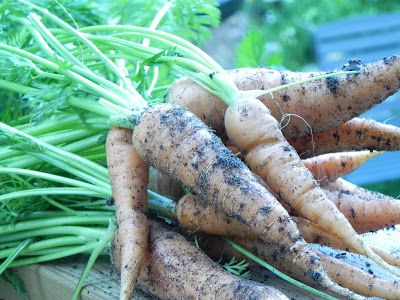Here is what I imagine to be the origins of this recipe.
Sometime long long ago, a particularly voluptuous (what can I say? I like my women curvy, and this is my fantasy) cave woman was carrying the mammoth bones left over from the slaughter to the pit for boiling when she tripped over one of her children's hastily strewn toy clubs...again. The bones slipped from her finger tips, arched across the sky and tumbled with a clatter into the fire.
She gave the boy a firm yet supportive reminder to put his toys away and proceeded to salvage the bones from the fire, As she approached, she noticed the charred licking of the flames had somehow intensified the mammothiness of the bones. On a whim, she threw the charred bones into the cooking pit along with some hot stones, and the roasted-bone broth was born.
And so, the course of human history was changed forever. I've adapted the recipe below for modern cooks.
1-2 stalks of celery, each cut in half
1-2 carrots, each halved lengthwise
1 onion, quartered
2-3 cloves garlic, crushed
2-3 pounds of mammoth bones - in a bind, you can use beef bones but make an effort to find mammoth
2 pounds stewing mammoth, in chunks - beef is okay but nothing beats mammoth
1 onion, roughly chopped
3-4 tablespoons olive oil
1. Place all the above ingredients in a shallow roasting pan or cookie sheet, drizzle with olive oil and toss to cover. Arrange the bones and meat on top of the vegetables
2. Roast at 410 degrees for about 40 minutes or until the bones/meat are browned and slightly charred.
3-4 bay leaves
stems from one bunch of Italian flat-leaf parsley, finely chopped
20-30 whole peppercorns wrapped in cheese cloth
3. Transfer the whole shebang into a large stock pot.
4. Place the roasting pan on a burner on low and pour in a cup of hot water and scrap every golden bit of awesome beefiness from the pan - this is what is going to make your stock gold. Pour this sweet liquid into your stock pot.
5. Add the bay leaves, parsley stems, peppercorns and hot water up to about 2 inches from the top of your stock pot.
5. Simmer on medium low for at least 4 hours, adding more hot water as needed.
6. Remove the solids with tongs or slotted spoon and strain the stock through cheese cloth drapped over a sieve into another pot. Put the cooked veggies into the dog pot but keep the meat.
7. Allow the stock to chill overnight in the fridge. Once it cools, the fat will solidify on top and can be easily scooped off.
8. This beef stock can be stored in an airtight container in the freezer for up to 6 months.
Roasting the bones makes all the difference. I recommend this stock be used for BFF Beef Barley Soup.














